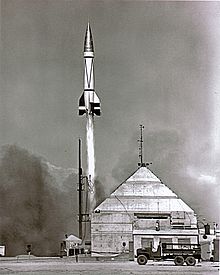
Back দ্বিতীয় আলবার্ট (বানর) Bengali/Bangla Albert II (aap) Dutch Albert II (macaco) Portuguese ஆல்பர்ட்டு II (குரங்கு) Tamil 阿尔伯特二世 (猴子) Chinese

Albert II was a male rhesus macaque monkey who was the first primate and first mammal to travel to outer space. He flew from Holloman Air Force Base in New Mexico, United States, to an altitude of 83 miles (134 km) aboard a U.S. V-2 sounding rocket on June 14, 1949. Albert died upon landing after a parachute failure caused his capsule to strike the ground at high speed.[1][2] Albert's respiratory and cardiological data were recorded up to the moment of impact.[3]
Albert II's flight, run by the Alamogordo Guided Missile Test Base and organized with the help of Holloman Air Force Base, followed the likely preflight death of Albert I before a 39 mi (63 km) high mesospheric flight aboard a V-2 rocket on June 11, 1948. The capsule was redesigned in-between flights to enlarge the cramped quarters experienced by Albert I.
- ^ Monkeys in Space: A Brief Spaceflight History
- ^ Beischer, DE; Fregly, AR (1962). "Animals and man in space. A chronology and annotated bibliography through the year 1960". US Naval School of Aviation Medicine. ONR TR ACR-64 (AD0272581). Archived from the original on December 4, 2012. Retrieved June 14, 2011.
- ^ "The Beginnings of Research in Space Biology at the Air Force Missile Development Center, 1946–1952". History of Research in Space Biology and Biodynamics. NASA. January 1958. Retrieved June 26, 2021.